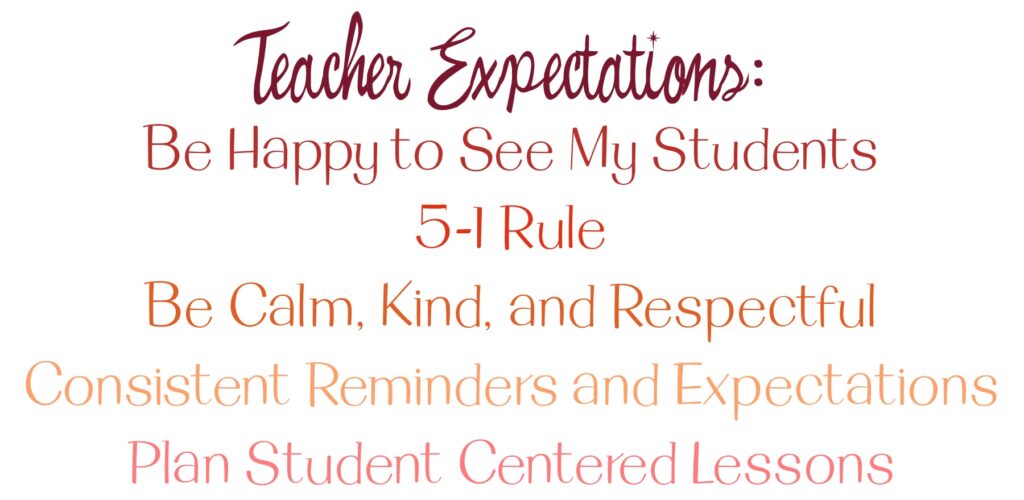As the teacher, my behavior is one of the biggest contributors to student behavior. I have to model consistent respect and work to create a positive environment. In turn, I can have the same expectations for them.

Be happy to see my students
Students must feel safe, supported, and valued in a classroom to be successful. This classroom environment is not just the end goal for my classroom management strategies, it is where they start. Greeting my students and always being happy and excited to see them each day, whether it’s first thing on Monday, or the end of the day Friday, is my first step in making sure they always feel wanted in my classroom. It is essential to start each class on a positive note- seeing the best in my students and giving them the opportunity to grow, not limiting them to past mistakes.
5-1 Rule
Starting with letting my students know, “I’m happy to see you”, I seek to follow the 5-1 rule. For every correction or issue I have to address, I should have already said 5 positive things to that student.
Keeping this guideline in mind student teaching, I became very aware of making sure I was encouraging, supporting, and complimenting all of my students consistently, and it meant the more a student challenged me the more dedicated I was to greeting them with a cheery good morning in the hall and encouraging their work. I have seen a simple “I’m happy you’re here today!” Every morning completely transform the behavior of one of the most disruptive students in my 7th grade class during student teaching. The student went from talking about how much he hated art, throwing pencils at other students, and generally trying to keep everyone from doing their work, to happily creating art.
Be calm, kind, and respectful
When addressing behavior, unless it’s dangerous to another student, my goal is still to frame it in a positive way. Instead of “stop talking, you’re driving me crazy”, putting the goal of a positive classroom environment in the students hands with, “I am so excited to see how amazing these are all going to look, but for us all to have a successful class we have to focus on our work instead of distracting other people” gives them a reason to listen. It’s essential to stay calm and not get into power struggles and arguments with students. Children learn how to behave more from observation then anything else, so yelling at them and reacting out of frustration does little more then teach them to handle things the same way. Simple phrases and repetition have worked well for me when students are attempting to argue. “Well I’m really happy you’re here” “I want you to be successful”, and even just restating a direction and walking away, have all worked well for me to avoid escalation.
Consistent reminders and expectations
Students all the way from K-12 have a lot going on in their minds and for many students art is not something they have every day. By displaying expectations and procedures, and taking the time to clearly remind students of them, we are setting them up for success. When teaching an art lesson, explicit instruction is necessary for my students to create successful art work and I must consistently remind them of safety, guidelines, and how to use materials. Other classroom procedures and expectations must also be taught explicitly and restated consistently. Expectations and guidelines should also be focused on creating a positive environment for students, and their success and learning, not simply compliance. Respect and kindness towards each other, and procedures that encourage responsible and safe behavior are essential, but the goal should be for students to make good choices because they care about their environment, not just because the rules say so
Student Centered Lessons:
Three of the main ‘triggers’ for disruption in the art room are when students are frustrated, bored, or disinterested in their work. To avoid frustration, lessons must be scaffolded so that students are learning and developing the skills they need to be successful. Consistent feedback is also key and lessons should be designed so there is as much work time for one on one support as possible, and feedback can be given between classes as well. Students also need to be provided with ample resources to do their own problem solving when stuck, whether that is through handouts, videos, or recorded demos. Creating a positive and respectful environment also means students can get support and advice from their peers. To combat boredom, preparation and planning are key. Downtime between steps, or drawn out transitions, can quickly lose the focus on students. Finally, art is a subject that every student can care deeply about if they are given the opportunity. Connecting art work to the lives and interests of students, and allowing them to make work that is meaningful for them, will create a care for their work that will naturally lead to a positive classroom environment.
By dedicating myself to creating and maintaining a positive and welcoming environment where my students feel valued, I am setting them up for success artistically and behaviorally and leading by example.